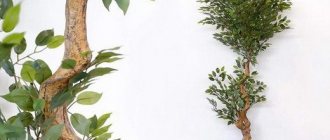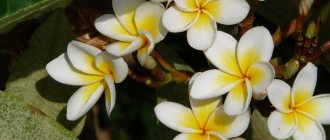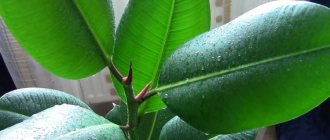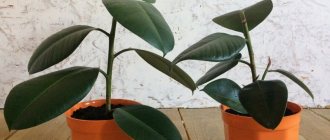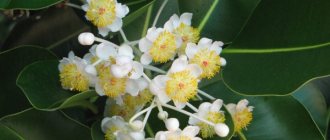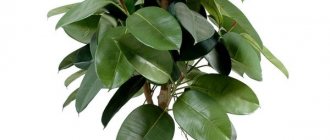Characteristics of the ficus plant. Ficus rubbery
Ficus rubber plant Ficus elastica
Characteristics of the leaves: the leaves are beautiful, dense, from 30 to 45 cm long, elongated oval, pointed at the ends. When grown at home under optimal conditions, the plant turns into a tree up to 2 meters high. Mature leaves are green in color, but the leaves of young plants are bronze in color. This type of plant is perfect for landscaping winter gardens, foyers and store windows. In winter gardens, small figs appear on old specimens - they are inedible.
The Himalayas, Burma, Nepal, the tropics of India, Sri Lanka, and West Africa are considered the homeland of rubber ficus. In these zones, the tree can grow up to 25-30 meters high. It is known from historical facts that in the 19th century they learned to grow the narrow-leaved form. Variegated forms are more difficult to grow than green forms.
In astrology, ficus rubber is a Capricorn plant, and affects a person on a physical and emotional level.
We present to your attention the most common forms of rubber-bearing ficus:
- Ficus Robusta - they have powerful and wide leaves, dark green in color.
- Ficus variegate - the leaves have light yellow, white stripes and spots, there are also pink shades.
- Ficus Black Prince (Ficus "Black Prince") is very similar in appearance to robusta, the leaves are almost black.
- Ficus doescheri – leaves have a red midrib.
- Ficus schrijvereana - there is a complex marble pattern on the leaves.
- Ficus tricolor - cream spots on the plant, as well as light pink stains on green leaves.
- Ficus elastica variegata - leaf blade with cream edges.
- Ficus diversifolia - the bush grows slowly, 1 meter high. The leaves are covered with brown spots.
When caring for such forms of rubber ficus, it is necessary to ensure the cleanliness of the leaf plate.
Be careful, if a leaf or cutting is damaged, the ficus releases poison.
After working with ficus, it is recommended to wash your hands thoroughly to avoid poisoning.
During the dormant period, if there is excess moisture or the soil is too dry, the rubber ficus may shed its leaves.
History and interesting facts from the life of ficus
All ficus, regardless of type, are heat-loving plants and are predominantly distributed in the Mediterranean countries, on the islands of the Indian and Pacific Oceans, in Western Africa, and Latin America. Some varieties of ficus can be found in Crimea, Central Asia, and the countries of Transcaucasia.
Ficus is a very interesting and ancient plant. The tombs of the mummies of Ancient Egypt, made from African ficus, have survived to this day. And who doesn’t know the fig or fig tree, also known as the fig tree, which has the status of a sacred tree for Muslims.
Ficus belongs to the mulberry family and has up to 800 species. Over the course of its many thousands of years of existence, this common plant has acquired a wide variety of life forms: from giant trees to very small dwarf plants.
It was also always called the “rubber tree.” This is explained simply. The jelly secreted from the stem and leaves of the ficus tree consists of 15 percent rubber. This is why ficus is used in industry.
The fruits of some types of ficus, for example, figs, contain about 75% sugars and have long been used by humans as a delicacy. In their natural habitat, the fruits of other varieties of ficus are the main part of the food of forest inhabitants.
In African countries and Mexico, rural residents use ficus leaves to cover the roofs of houses in the construction of houses.
If we talk about the home ficus, then everyone knows this common plant from childhood, which has a strong trunk and large, juicy green leaves. In the past, ficus decorated the window sills of almost every home, personifying order, stability, peace, and a correct way of life. And even, at one time, it was synonymous with philistinism.
In recent years, ficus has again begun to experience a huge surge of interest in it from gardeners, thanks to its extraordinary diversity, beauty, and unpretentiousness. This plant has become one of the main decorative elements, especially in country houses, where it became possible to provide this beauty with sufficient space and the necessary lighting.
At home, the plant brings many benefits, purifying the air in the room and creating coziness. This versatile plant has a lot of other beneficial properties, sometimes unexpected and extremely interesting.
So, let's get to know ficus trees better.
Ficus Wikipedia. Ficus
Wikipedia - ashyk encyclopediasynan alyngan malimet
Ficus (lat. Ficus) – here we are reaping, we are reaping, we are reaping the fruits. Tuysynda 1500-2000-ga zhuyk turi is called “Rubber ficus” kop osiriletin turi. Sonymen qatar, “Benjamin ficus” and “Elastica ficus” degen tүrlerіn de osіrushiler qatary kobeiіp keledi. Ademi zhapyraktaryna bola guldi nagyz mekeme guli dep itady. Degenmen de ficus kopshilikke en aldymen kop kutimdi kazhet etpeytin “konbistigmen” tanimal bolgan shigar. Bugingi without aitkaly otyrgan ficus “rubber ficus”. Ficus rubber is more difficult. Algashynda, zhasyl, zhalpak zhapyrakty bir turi bolsa, kazirgі kezde sary ala, ak ala, kyzyl ala zhane usak zhapyrakty, fights alas sekildi birneshe turі shygary ldy. Barlyk turіnіn kүtimі birdey. Olardyn bir-birinen ayirmašylygy zhapyragynyn tusterinde gan.
Tike tusken kun saulesin kotere almaydy. Ala zhapyrakty turleri zharykty unatada, kolenkede ala tusin zhogaltyp, zhasylga ainalyp ketedi. The heat is still on the boiler.
Once upon a time there lived a suygish asimdik. The temperature is 16-180C tomen bolmagany durys.
The yellow barlyk should be removed from the sugar. Topyragynda sudyn tosylyp kalganyn unatpaydy. Sugaratyn sudyn more temperatures and dengeyinde zhyly bogany durys.
Zhapyraktaryn dymkyl matamen surtip turu kerek. Ol fikuska әrі ylғaldylyқ berip, әrі zhapyraktaryn shanan tazartada. As a matter of fact, it says.
Fikustyn barlygy shirigen konmen kunarly topyrakty unatada. Koktem kezinde topyragynyn betki kabatyn tazalap alyp, zhana topyrak salyp turgan abzal.
èrmekshі, қ ұтақ саңырууұлағымень, асімдік імдік імініурды. Kez kelgen auru ficuska kop sugargannan zhane tazalyktyn zhoktygynan keledi.
Let's call it a day.
Option No. 2
Ficus is a tree that remains green at any time of the year. In addition, there are also species that can easily and simply spread on the ground and in this they are helped by adventitious roots. Typically trees grow to about forty meters. The diameter of this tree reaches about five centimeters.
There are even types of ficus that grow due to the plants that grow next to them. A little later they develop special adventitious roots, and then they grow and become columns. The leaves measure approximately seventy centimeters. This type of plant has a special milky juice. Their flowers are usually small in size and resemble a ball or pear shape. These ficus plants are pollinated with the help of special insects that carry pollen from one plant to another on their paws. After pollination has occurred, the walls of the ficus become either thin or thick.
Read also: How long does a Saanen goat live?
Today we can confidently say that there are about a thousand different species in total. In its homeland it grows large roots, vines or shrubs.
Of course, there are those who like to grow it at home. Mostly grandmothers like to grow them. Ficus is a medium-sized plant. It has large and also elliptical leaves. It also has a special milky juice. It adapts to the climate in which it has to grow.
If you have a ficus with variegated leaves, you need to care for it with care. And all because he is very demanding of care.
If you have ficuses with small leaves, then in this case he really likes to drink water. And in no case should the sun's rays fall on it, because it can die from them.
In order for them to grow well, they need good and high-quality drainage. Ficus is practically not adapted to living at home. It is most suitable for work areas or greenhouses.
When you grow it at home, you do not allow it to grow to its full height. Because you constantly prune or plant in a cramped pot.
It is best to transplant it into another pot in the spring. And it is best to do this once every two years. And if you put it in one place, then you don’t need to constantly rearrange it. It likes to stand in one place, and if you move it, it may simply shed its leaves and not grow for a very long time.
2, 3, 4, 5, 6 class flower
Ficus description for children. Ficus benjamina description for children
- one of the most popular decorative foliage indoor plants. Its homeland is South Asia, the Philippines, and Australia. In nature, it is a large bush or tree, reaching a height of 8 - 10 m; in indoor conditions it grows up to 1.5-2 meters. The trunk is gray with small streaks. Branches inclined downwards. The leaves are on small petioles 2-2.5 cm, the leaf blade is oval with an elongated tip 4-8 cm long and 1.5-4 cm wide. The central vein is not clearly expressed. The sheet is dense and glossy. Leaf color varies from light green to very dark, and there are many variegated forms.
Indoor varieties
Ficus benjamina has a huge number of varieties, differing in the size of the leaves and their variegation.
Ficus benjamina variety Daniel
Variety "Daniel" - distinguished by very dark, monochromatic leaves.
Ficus benjamina variety Monique
Variety "Monique" - has more delicate, thin branches and a light leaf slightly wavy along the edge.
Ficus benjamina variety Nicole
Variety "Nicole" - has a more elongated leaf with a light edge.
Ficus benjamina variety Safari
The “Safari” variety is distinguished by its obvious spotting and tricolor color.
Ficus benjamina variety Baroque
The Baroque variety is the most unusual and difficult to grow. Each leaf of this miniature plant is twisted into a spiral.
Accommodation
Prefers bright, but not sunny places. In summer it needs shading from direct sunlight, which can cause burns on the leaves. The required amount of lighting also depends on the variegation of the leaves - the more variegated the leaves, the lighter the plant needs. If the ficus is located in the back of the room, it needs to be provided with additional lighting with a fluorescent or phytolamp. It is advisable that the backlight be located directly above the growth point, in this case the crown will be more symmetrical.
The plant does not tolerate drafts and responds to them by dropping leaves.
In the summer, ficus benjamena can be taken to the balcony or garden in a place protected from the wind and direct sunlight. However, in this case, after bringing the ficus indoors, due to sudden changes in living conditions, it will shed some of its leaves.
Temperature
Prefers a temperature range of 20-25 °C, in winter not lower than 15 °C. Provided proper watering, they can tolerate higher temperatures. A temperature drop below 15 °C will lead to massive leaf fall, and a temperature below 10 °C can lead to the death of the plant.
If the temperature in the room drops and it is not possible to move the ficus to a warmer room, the lump of earth should be well insulated. By maintaining the temperature of the roots, the ficus is able to tolerate lower temperatures for some time.
The plant should not be placed near heating appliances.
Watering
Watering is moderate after the top layer of soil dries. The plant reacts to overdrying by dropping some of the leaves; from overwatering, the leaves become light and the roots can rot. In winter, with cooler conditions, watering is slightly reduced.
Watering is done with warm, settled water. The water is drained from the pan.
Humidity
For more intensive growth, it is advisable to regularly spray with warm boiled or filtered water. However, the plant grows well without spraying, easily adapting to the conditions of the apartment.
Only in winter, in hot apartments with central heating, it is advisable to spray the leaves to avoid losing some of the leaves. From time to time, it is advisable to wash the ficus in the shower to wash off dust from the leaves. If the size of the crown allows, the crown can be completely immersed in water for a few minutes.
Top dressing
From spring to autumn, ficus is fertilized with universal fertilizers for ornamental foliage plants, diluted in a slightly lower concentration than indicated on the package.
In winter, when kept in cool conditions, fertilizing is stopped; when kept in warm conditions, fertilize once a month with fertilizers diluted in an even lower concentration.
Fertilizers are added to the water for irrigation and watered over the already wet lump of earth.
The plant responds well to treatment with Epin, which stimulates faster crown growth.
Transfer
Young specimens are usually replanted once a year in the spring, adults - once every 2-3 years, when the roots entwine the entire lump of earth. In large plants, it is permissible to replace the top layer of soil instead of replanting.
Pots can be ceramic or plastic; a drainage layer is required. The size of the pot should only be 2-3 cm larger than the previous one.
For planting, universal store-bought soil is suitable, or you can make a mixture of peat, leaf soil and sand in a ratio of 1:2:1.
Reproduction
Propagated by seeds, cuttings and air layering.
Secrets of transplantation
Young plants grow quickly, and therefore they are replanted annually until they are 5-6 years old. Large adult specimens are usually found in large containers: barrels, tubs, so moving them is problematic. Once a year, replace the top layer of soil with a new substrate. This procedure is carried out if salt deposits appear on the surface.
The soil should be:
- nutritious;
- loose;
- from slightly acidic to slightly alkaline;
- good fluid permeability.
You can use soil mixture from a flower shop, but it is better to prepare it yourself. A soil substrate is suitable for ficus plants; to prepare it, take one part of humus, peat soil, turf soil, fine gravel and add two parts of leaf soil.
The pot should not be too spacious. The plant is replanted when the root system completely fills the container and the roots penetrate the drainage holes.
To transplant a ficus, you need to follow these steps:
- Select a container of the appropriate size. Check for drainage holes; if there are none, drill them. They are necessary to prevent putrefactive processes due to stagnation of moisture.
- Place a drainage layer of broken brick, clay fragments, and expanded clay on the bottom.
- Prepare a sufficient amount of soil mixture.
- Before transplanting, water the large flower several times to completely moisten the earthen ball, this will make it easier to remove it from the container.
- Tie up the branches of the bush so as not to break them during the operation. Tilt the tree and move the soil away from the walls. You can pull the ficus by the trunk.
- If the plant has not been properly cared for, the roots may break when removed from the container.
- Place the removed cactus along with a lump of earth in a new container and sprinkle with soil. The root system must be handled carefully, since large specimens are difficult to tolerate root injuries.
- They begin to water the plant a few days later, as it was moistened during transplantation.
A month after the procedure, the tree can be fed with fertilizer with a high phosphorus content to improve root growth. For further fertilizing, you can use compositions for decorative deciduous crops.
Important! Read how to replant a cactus.
Ficus propagation. How to propagate ficus?
The ficus genus includes more than five hundred different species of plants, both indoor and wild. But ficus is popular precisely as a houseplant. The main role in this popularity is played by the variety of ficus forms. It may look like a small tree, vine or bush. The genus of ficus is also distinguished by a large number of variations in the shapes, colors and sizes of its leaves. Many also believe that ficus is an absolutely unpretentious plant, but this depends on its type - there are also quite capricious ones.
Reproduction of ficus requires the implementation of certain recommendations so that the parent plant is not damaged, and the shoot takes root and grows into a new healthy plant.
Peculiarities
In order to propagate ficus correctly, identifying its type will be useful, but not necessary. The propagation methods listed below are suitable for all species. But, based on each specific type, you can choose the one that will be most comfortable. Ficus is an indoor flower, but with its own needs. They need to be taken into account during future reproduction. Such features include a love for warmth and a dislike for bright light, a preference for a certain soil, periods of an active phase and a resting phase.
Low temperatures are contraindicated for ficus plants, so the plant needs to maintain an optimal temperature and avoid sudden changes. This is especially true during the breeding season and winter: the sprouts will not survive at low temperatures and without providing them with the necessary temperature conditions either. Winter is not suitable for growing ficus plants, since the flower is dormant, and, most likely, the plant will not take root and will simply die.
Before carrying out the transplant, you should read the instructions step by step in order to do everything correctly and get the desired result. If all the requirements and tips are met, it will not be difficult to propagate ficus.
Preparation
Before carrying out the propagation process using any of the available methods, you need to prepare everything you need. It is better to prepare a special place where all subsequent actions will be carried out, so as not to carry the plant pot, tools, etc. from place to place during the process. And also to immediately provide the plant with everything it needs. If side shoots are required for propagation, their growth can be influenced in advance. To do this, you need to trim the ficus in a timely manner. The top is usually cut off, after which shoots will begin to appear on the sides of the plant.
Depending on the method, you may need special tools - these are regular scissors or a knife with sharpened blades, a stationery knife, or a blade. A blunt instrument is absolutely not suitable, since it can injure both the plant itself and the future seedling, which will lead to death. If for propagation, in addition to cutting tools, special mixtures, containers for germination, etc. are required, all this must be prepared in advance. You need to prepare the necessary soil and drainage.
What to do if a ficus leaf turns yellow?
There are several main reasons for yellowing and dying leaves:
- Natural aging. Each leaf, depending on conditions, lives for 2-3 years. After this it turns yellow and falls off. Natural dying off is never widespread. On the plant, no more than 1-2 leaves located in the lower part turn yellow at the same time.
- Stress . Moving the pot to a new location or replanting can cause massive leaf fall. In some cases, the plant is almost completely exposed. In such a situation, a growth stimulator is used. For example, Epin or Zircon. 2-3 days after their use, the ficus is fed with complex mineral fertilizer.
- Failure to comply with the watering regime . Overdrying or flooding can also cause yellowing of the leaves. In this case, it is enough to adjust the watering regime and the plant will gradually recover. Ficus is watered after the top layer of soil has dried. To prevent stagnation of irrigation water in the pot, drainage must be installed.
Popular reports
Equestrian sport was founded in the Middle Ages during the Olympic Games, which could threaten human life. The essence of this competition was a chariot race on which a Roman stood; whoever arrives first will win.
Herbivores or also called herbivores are creatures that eat plants. Such plant products include leaves, roots, fruits, etc.
There are quite a lot of beautiful places in the Krasnodar region and it is impossible to cover them all. Kuban is an ancient territory with a long history. Wonderful places in the Krasnodar region include the Caucasus, the most beautiful shore of the Black Sea
Abdulova Dzhume Sirazhutdinovna
"My houseplant." Children's stories
She invited the children to draw and write about indoor plants at home with their parents. This is the story and picture our girl with the flower name Lily came up with.
"The Joyful Singing of Flowers"
Mom planted flowers in the clearing. I watered it with fresh water. The flowers liked the warm water. And they smiled at mom, and mom smiled back at them. Mom called the flowers daisies. They were very beautiful and as if alive. The daisies sang songs to each other and danced joyfully. The sun was shining and smiling at them. The sky floated above them like waves, but it was not waves. And the sun was so bright, as if we were in the desert. The daisies reached out to him, and the roots kept going down into the grass. The flowers made everyone happy and even sang songs.
And here’s another story Danil and his parents drew.
"Ficus"
I will tell you about our indoor plant - ficus. He appeared in our family three years ago. All this time we looked after him: watered him, sprayed him, wiped the leaves, talked to him. Thanks to our care, new young leaves appeared. Ficus creates a good mood in our house for my whole family.
Exhibition in kindergarten. I will be a flower grower Dear colleagues, I bring to your attention another exhibition of photographs and drawings with children’s stories about their indoor plants. For children.
Read also Honey is bee poop
Wall newspaper "Happy Mother's Day!" Mother's Day is coming soon. The children and I sang songs and listened to about our mother for a whole week. We read and learned a poem about our beloved mothers. The photographs were upsetting.
